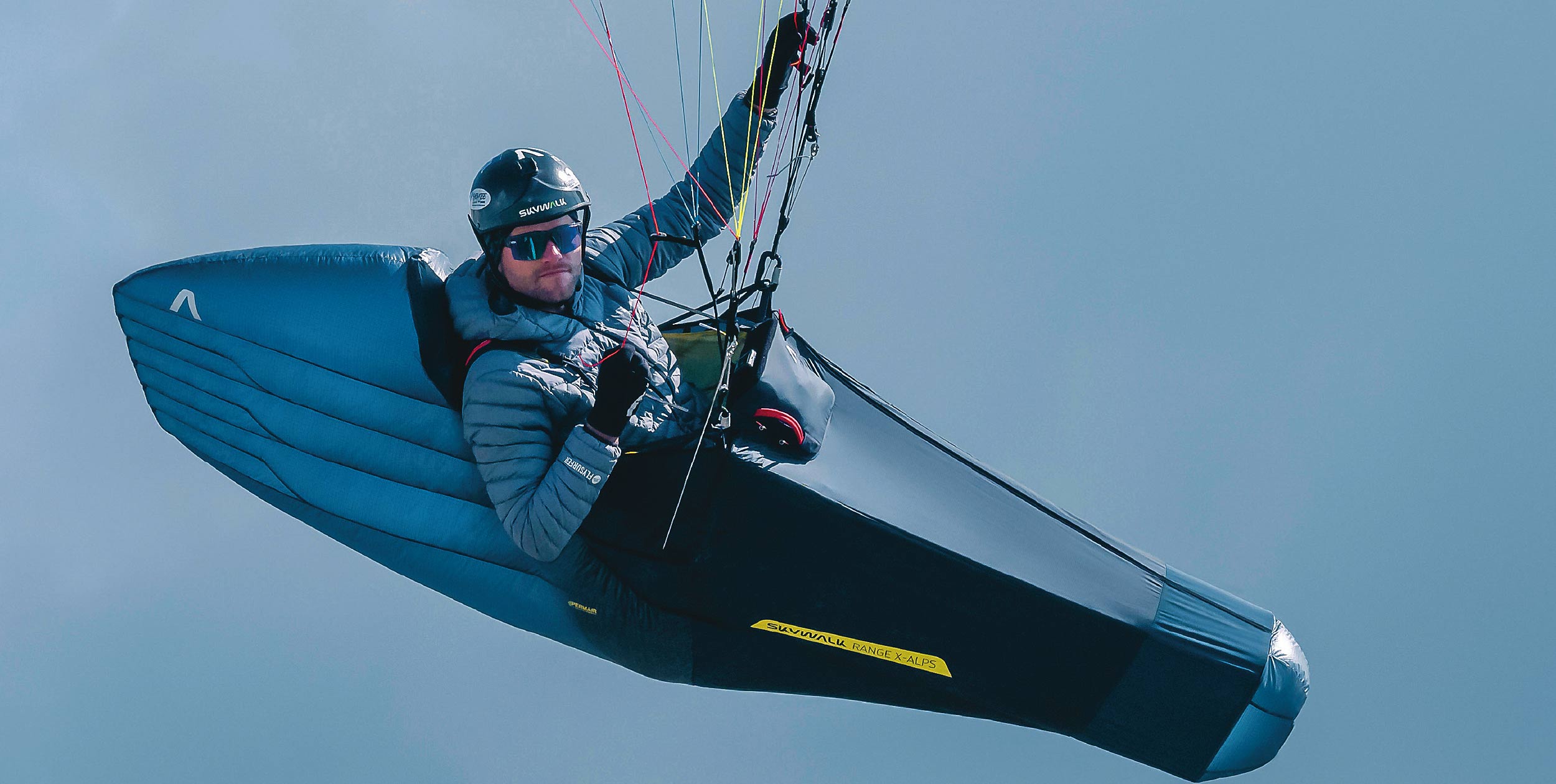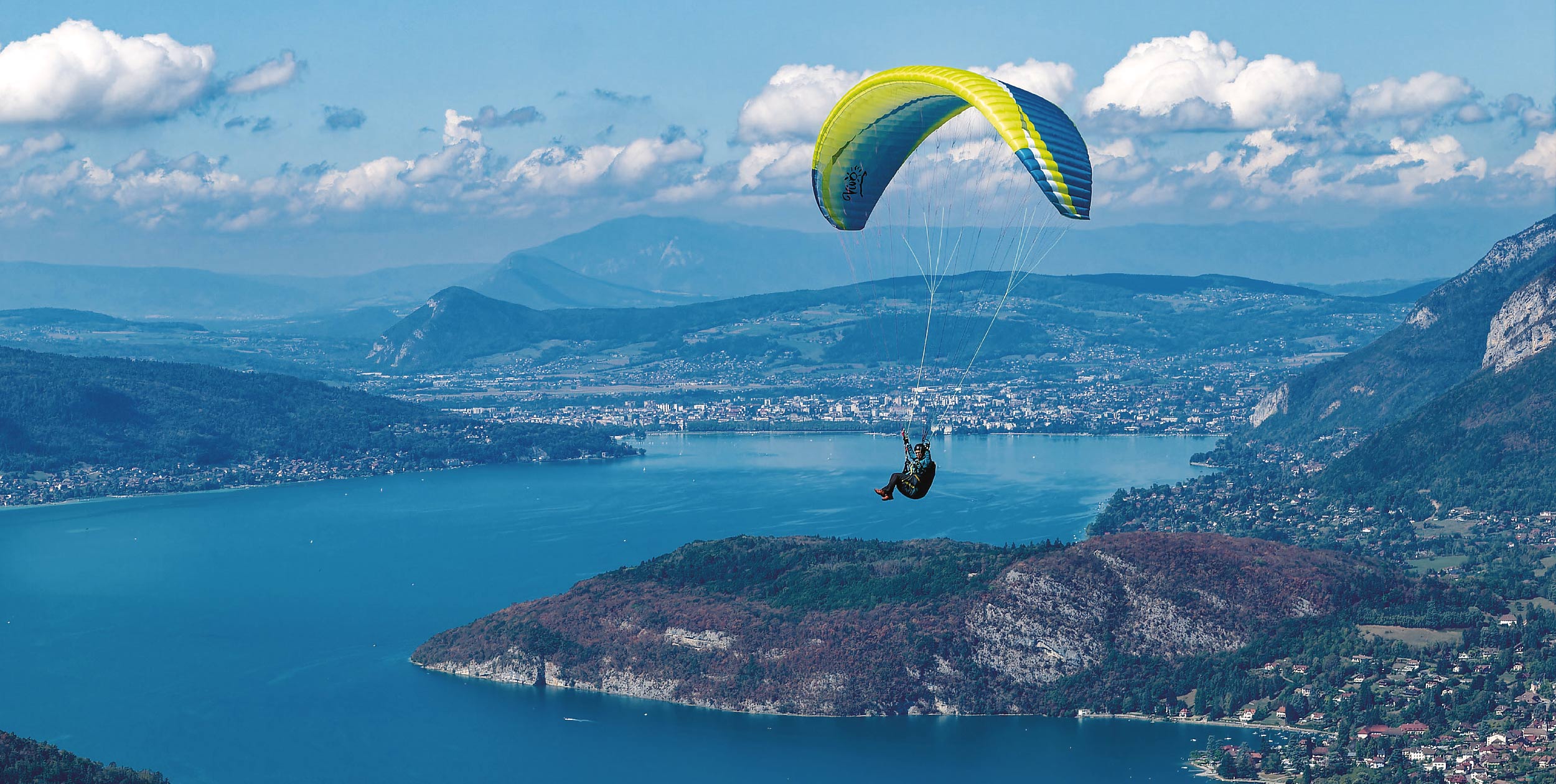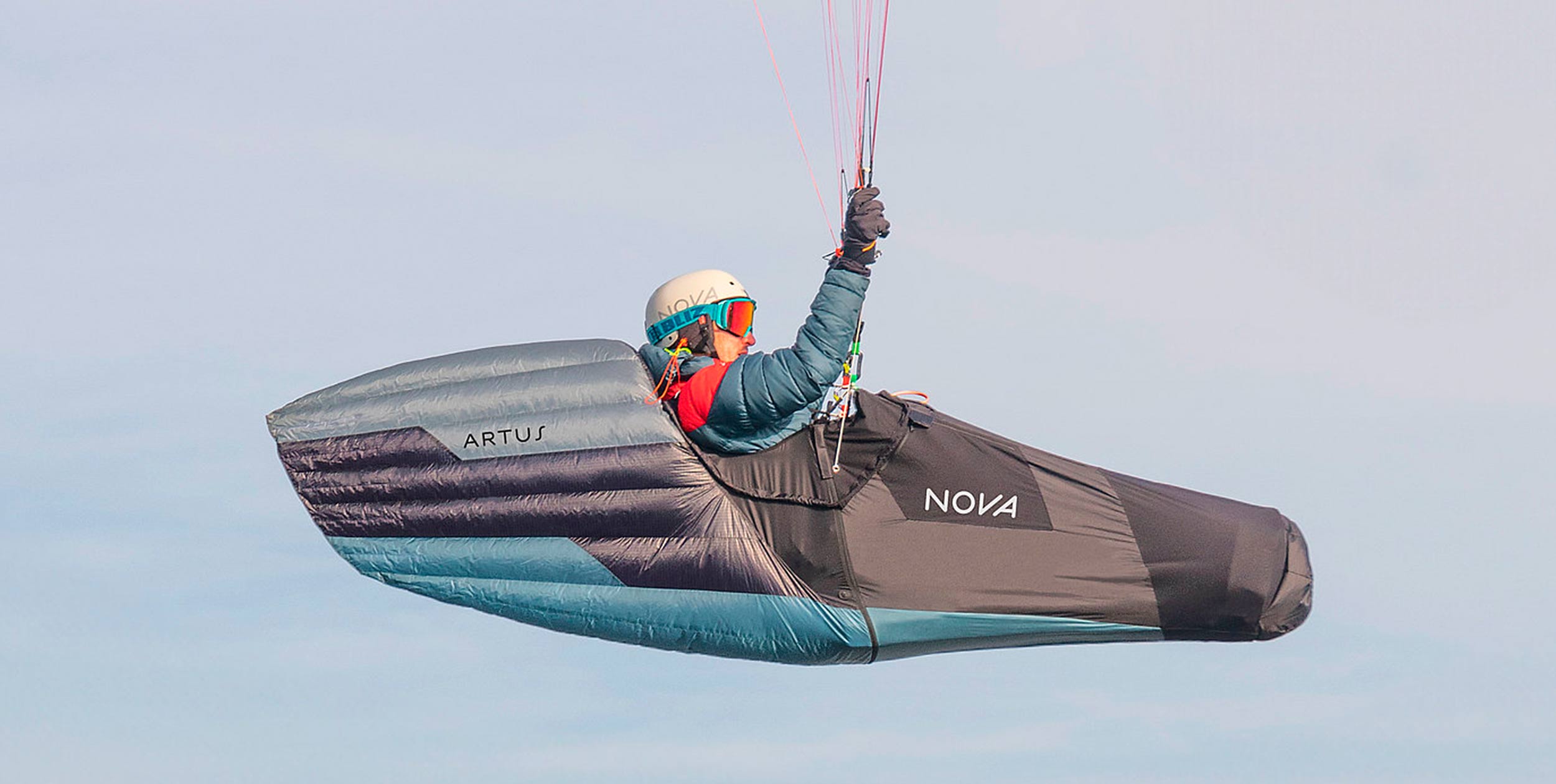Nice to Geneva by paraglider, a classic vol-biv adventure. Clip: Sharemyjoy
In his everyday life, French pilot Pierre Bouilloux designs harnesses and accessories for paragliding. Occasionally, when the weather looks particularly good, he nips out and has a crack at the FAI triangle or some other record which he breaks fairly regularly. Once a year though, he puts work aside for longer, takes a minimum amount of equipment and heads off for a vol bivouac through the Alps: completely alone – tout seul – in flight over the mountains. Pierre speaks about his love of bivouac flying to Carla Beekman. Published in Cross Country magazine in 2004
I’m fascinated by areas that are still unspoiled and wild, untouched by man. I still manage to find these areas on my travels. Even the Alps are still extremely rough and empty. I love the area. They are my ’own’ mountains and I feel very much at home there.
The great thing about vol bivouac is that you can stay in the mountains. You hike and you fly; in fact, you try to outsmart nature. You walk where you can’t fly and fly where you can’t walk. When you spend so much time surrounded by nature, you have a great deal of opportunity to reflect, relax and observe. That freedom and communion with nature – nowhere else can you experience it precisely like this. Magnificent!
A thick line
Before I leave, I gather information about the airspace. I know many of the areas well enough to know whether or not you may fly over them and whether you must stay at a certain altitude, such as in military areas or nature reserves. I take a map that provides just enough detail to give an overview of my route. I don’t take a GPS, just a small acoustic altimeter and a compass.
Once I’m on my way, I generally deviate from the route I planned. Sometimes I see possibilities to get somewhere more quickly. Sometimes I adjust my plans because of the weather. You can’t prepare for everything.
Once, I wanted to fly from my home in Annecy over the Alps to Slovenia. I asked the advice of a celebrated hang glider pilot who’d once flown the same route. I asked about the route he had chosen, the difficult transitions, the problems he had encountered, and how he solved them.
Using a big, black felt pen, he drew a thick line over the Alps. ’Don’t ask me all those questions,’ he said. ’In principle, you can fly anywhere. Of course, some routes are better and if you make the wrong choice you will have to walk more. But if you want, you can fly over the Alps!’
No mistakes
What is truly special is flying in unknown terrain for about 20 to 35 kilometres. In my area, I know all the tricks needed to execute a certain crossing. In a new area, I don’t know them and have to think very carefully in order to fly over that area efficiently. If it is also an area you can’t cross on foot, then it’s an amazing experience if it works.
It takes an enormous amount of concentration to avoid mistakes, and that’s what I find challenging. A mistake means you can’t find any thermals to lift you and you have to land below and walk back up. Once, after such a mistake, I had to walk for six hours in order to reach the next starting place. That’s why I’m always delighted if I’m able to fly all the way up from a valley.
If you use the thermals well, you can watch the landscape while you’re rising. It’s fantastic. First you fly just above the trees, often with no way out, then suddenly a thermal comes along to save you, and you rise above the forest, the rock walls, the snow, the ice and, finally, above everything and up to the clouds. It’s out of this world.
Out of the mountains
The best weather for a vol bivouac is a high-pressure area with little wind. I try to stay as high as possible and to fly at between 1500 and 3000 metres. It’s very impressive to be up at that altitude.
The landscape is beautiful. It’s cooler, and where rocks and snow are alongside each other, you can almost always find lift. Moreover, you have the advantage that there’s always clean water available, straight from the mountains.
The number of kilometres I fly per day isn’t important. I’m more interested in the beauty of the flight. Of course it’s fun if I manage to fly 100 kilometres or more, but sometimes I have days in which I only do 15 which were much more difficult and hence more interesting.
The end of a flight – wherever it may be – is always a surprise. You fly in the last thermal of the day and look out for a good place to spend the night. You look for water, a piece of flat ground, a place to start from the next day and maybe even a shepherd. And just as you decide to land, you unexpectedly pick up a fantastic thermal and fly on!
So tired
Landing is always tricky. Almost always, you’ve been flying for a couple of hours and then suddenly you have to make a good landing somewhere between rocks and boulders on a tiny, grassy field.
Thus far, I’ve never really been hurt, only a couple of slight injuries. I prefer to come into a landing spot from an altitude of about 200 metres so that I have enough time to judge whether or not I can land safely. I’m always happy when I’ve landed nicely so that I don’t have to sit and fret all evening long about the poor landing I made.
The bivouac spot itself should, of course, be absolutely beautiful! After all, you have to spend the whole evening, all night, and next morning there. The interesting thing about a bivouac spot is that you keep experiencing your surroundings from a different perspective: first from above whilst flying, often in the sunset … Then, after landing, there’s suddenly a completely different perspective and by morning the mountains again look entirely different.
Of course, it’s also important that water is available, as well as a good spot to start from the next day. Once you’ve landed, you’re sometimes so tired you just want to lie down immediately and do nothing else. You can’t do that, even if you’re completely wiped out. You must take care of yourself. That’s the way to stay mentally strong and to avoid physical problems.
I carry some first aid stuff with me and, in particular, some medication to combat any possible infections. However, good hygiene is absolutely essential and that requires an enormous amount of discipline.
Too heavy
It’s important that you stay warm, particularly during the evening when you’re tired. The clothes on my back are the only ones I take with me and they’re made from materials that dry very quickly. I wash them in the rivers and while I’m walking, I hang them from my backpack to dry. These days, they make very thin jackets and pants of Gortex. If you wear warm underwear and polar fleece you’ll be warm enough to fly.
My shoes are made of leather and Gortex. They’re getting a bit old now but I trust them completely. It’s going to be a problem when I have to replace them! I also take a lightweight inflatable mattress with me, and an 800g down sleeping bag. I make my tents myself since those available on the market aren’t good enough and, more importantly, are too heavy.
The tent is extremely important. It alleviates some of the stress of staying dry. The tent I have now weighs 700g and goes up in no time. It’s made of lightweight rip-stop and is fully glued on all seams. It has lightweight, flexible fibreglass poles and even fibreglass pegs. The underside of the tent has a layer of Mylar for strength.
Flying again
In the morning the first thing you do is assess the weather. You do that by observation. Early clouds on the eastern face of the mountains mean instability and possibly a chance of thunderstorms. In this case, your best bet is to start flying immediately and to stop early.
You can generally see the wind as well, but sometimes, you don’t see things coming until you’re in the air – for example, that the air is too turbulent, the wind is increasing rapidly, or that the clouds are unexpectedly becoming too large. Then, it’s important that you have good control over your paraglider and that you have enough training to land safely somewhere else.
So, when I’m flying, I don’t only keep track of the thermals and the route, but I also keep a constant eye on the weather. I want to make sure that there are no surprises.
No weather for flying
If it’s too dangerous, if the wind is too strong or there’s a thunderstorm, I go hiking or I bivouac at my chosen spot. I’m really afraid of thunderstorms. I once left all my things on the mountain, and descended as quickly as possible to a safer spot.
You can sometimes hear the electricity. It’s just like a swarm of bees. Sometimes nothing happens, sometimes it gets louder. When that happens, it’s really terrifying, all you can do is pray, because then you know: you are absolutely nothing.
But being in the mountains during bad weather can also be beautiful – especially in the Alps with all those clouds. Then it’s nice if you have something to do. I write, listen to music – I always have a couple of CDs with me – or I play the harmonica.
Mentally, it’s certainly better to keep moving. It doesn’t have to be all day long, but it should be for part of every day. That means walking. The backpack I’ve designed for this weighs 1100g and can hold 110 litres. It’s constructed in such a way that when the paraglider is packed inside, it forms a sort of frame.
The rain hood weighs 100 grams. I am not terribly strong, so it is important for me that the total weight of my gear is less than 20 kilos.
One problem
I prefer to do vol bivouac alone. Only then do you have total freedom to make decisions and it’s also easier to make contact with people. I’ve had some beautiful experiences with shepherds. Once, I stayed with one for two days, helped him, and learned a lot about herding sheep.
Every once in a while, I meet very interesting shepherds. Some read a lot, play music or do something interesting at the spot they have chosen to spend their lives in. Sometimes we find that our philosophies of life are very similar.
I also see a great number of animals on my trips and mountain goats are a continuous source of amazement to me. They can stand on the steepest slopes and generally the adults don’t run away when I fly near them. It’s different story with the young goats. I make sure that I stay away from them. If they flee up the rock face, there’s a good chance that one of them will fall off.
I often fly with eagles. They don’t leave. Actually, there’s only one problem: they fly better.
No toys
I take the absolute minimum with me. That’s precisely what I like so much about it. I love travelling for a couple of weeks in a stunning area with practically nothing – no stuff. Gone are all the toys that make life so busy and complicated: the phone, the computer, sometimes even a lifestyle that doesn’t make you happy.
I do take good food with me, well … I take along everything that I like! I try to make my five-day rations last for ten days. That’s a problem when I play my harmonica because I have to sit at one side of the tent while the food takes up the other!
I generally reach a mountain cabin in time to buy some more food. I don’t take a burner with me, I would rather bring along a few more harmonicas. I don’t have a pan, either. I just have matches so that I can make a fire and one large cup to warm something up in.
Because of the great pressure from my family, I’ve recently started to carry a mobile phone with me. I would use it only in dire emergencies, but it does tend to breach the dream a bit. It is precisely my dream to be completely cut off from the rest of the world and its luxuries. The dream is to live solely in the world of the journey.
Anyone who thinks that a trip like this is a piece of cake is sorely mistaken. You can have a run of bad luck with your canopy or you can get injured. Ironically those are just a couple of the reasons why I do this. I like to see how my brain reacts to certain situations.
You can be terribly depressed and no longer know what to do and then suddenly see the humour of the situation. During the first few days, I feel pretty vulnerable. Everything has to be perfect or I’m not happy. A couple of days later, that starts to change. I become psychologically stronger and I’m also happy when things don’t go well. Then, towards the end of the trip, I feel like I’m in a dream.
Some of Pierre’s specialist bivouac equipment can be found on the Supair website www.supair.com
Translated by Sandra R. Reijnhart
• Got news? Send it to us at news@xccontent.local. Fair use applies to this article: if you reproduce it online, please credit correctly and link to xcmag.com or the original article. No reproduction in print. Copyright remains with Cross Country magazine. Thanks
Subscribe to the world’s favourite hang gliding and paragliding magazine







